Why do I need another root canal on a previously treated tooth?
With appropriate care after the procedure, most endodontically-treated teeth that are properly restored (usually with a core foundation and crown) can last as long as natural teeth. In some cases, however, the disease may not heal and might not be detected for months or even years after the initial treatment.
What You Need To Know About Root Canal Retreatment
Lack of healing is caused by bacteria that contaminate the previously treated root canals. Bacterial contamination usually occurs because of a problem that developed after the initial root canal treatment: new tooth decay, a cracked tooth, delay in properly restoring the tooth, or a broken filling.
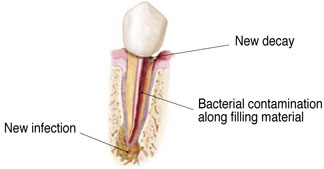
Reproduced with permission from the American Association of Endodontists
Bacteria can also contaminate root canals that have very complex anatomy or calcifications that were inadequately treated during the previous root canal treatment. Due to scientific advances, an endodontist can often give your tooth a second chance by using technology and techniques that may not have been available when you had your first root canal treatment.
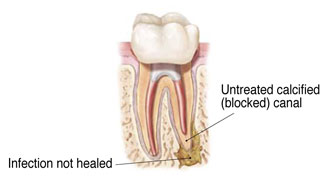
Reproduced with permission from the American Association of Endodontists
After numbing the tooth, the problem that allowed bacteria to enter the center of the tooth is corrected by removing tooth decay or cracks. If enough healthy tooth remains after this process to allow your dentist to rebuild the missing tooth structure, root canal treatment begins. An opening is made through the chewing surface of your tooth to enter the pulp chamber—the center portion of the tooth where pulp tissues from different root canals merge together.
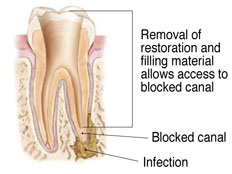
Reproduced with permission from the American Association of Endodontists
Once the canals and chamber are cleaned and dried, the root canals are filled with a rubber-like material and adhesive cement. The pulp chamber and opening in the chewing surface of your tooth are then filled with a temporary filling material to protect the root canal treatment until your dentist can rebuild your tooth.
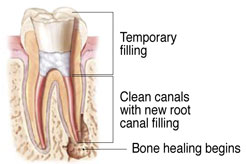
Reproduced with permission from the American Association of Endodontists
Properly performed root canal treatment decreases the number of bacteria in infected roots by more than 99% and promotes healing of infected tissues surrounding teeth that could cause serious health problems if left untreated.
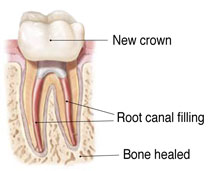
Reproduced with permission from the American Association of Endodontists